SCIENCE
and scientific communications
SCIENCE
and scientific communications
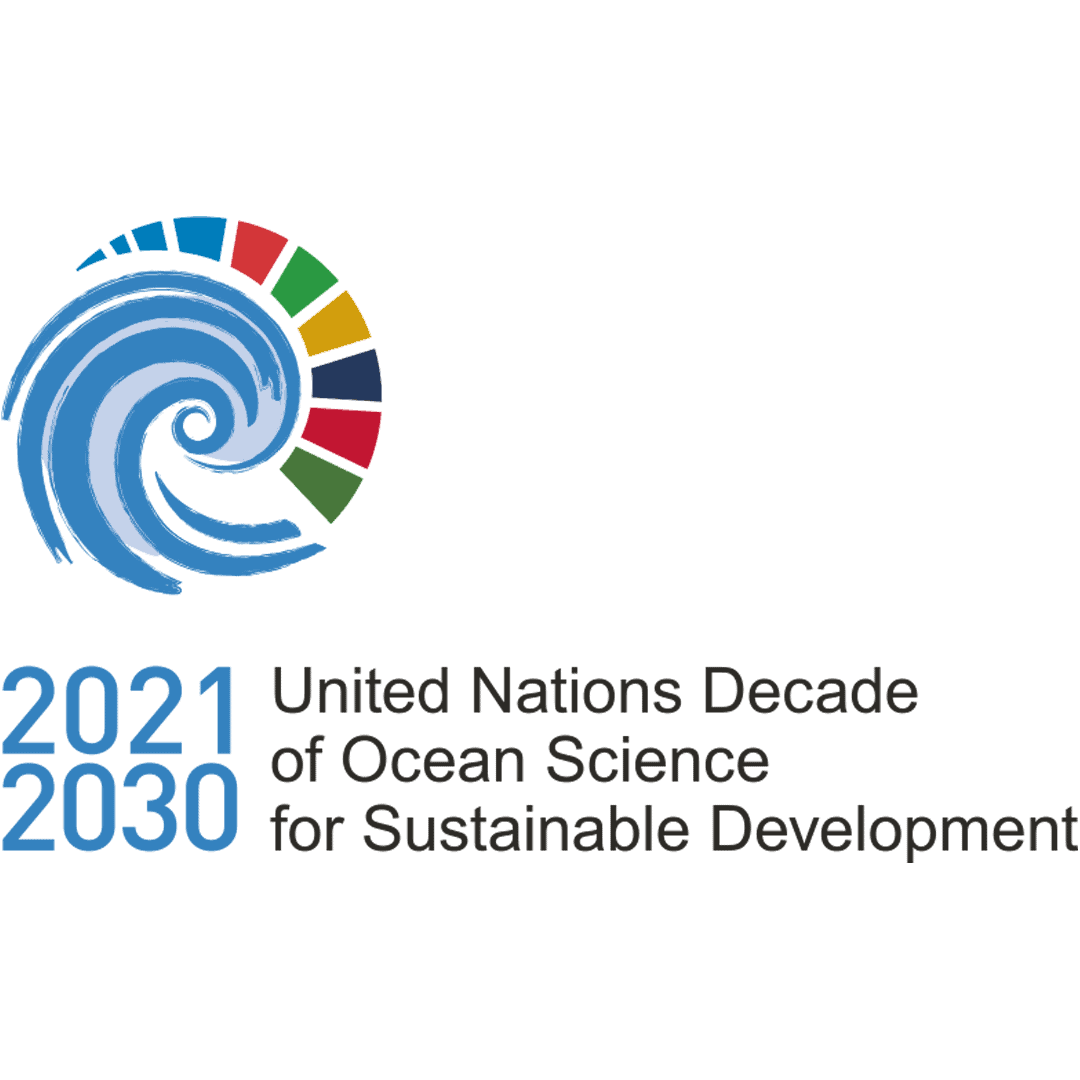

The DEEPLIFE program, based on a unique collaboration between UNDER THE POLE and international scientists, aims to discover the marine animal forests of the mesophotic zone (30-200 m) and their key role in the functioning of the marine ecosystem.
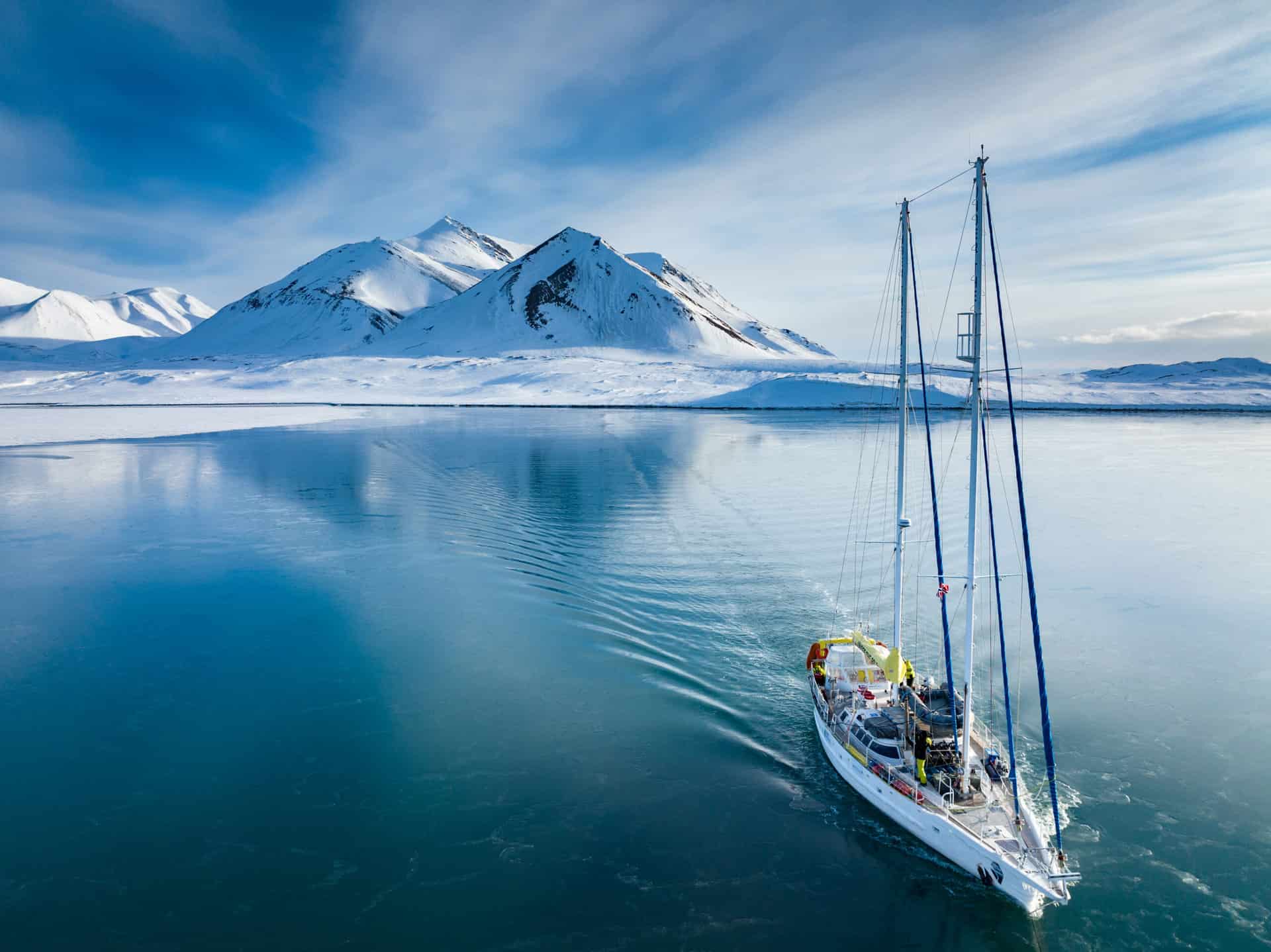
During a world sailing tour from the polar regions to the tropics through temperate regions, field observations, sample collections, and laboratory experiments will provide a precise identification of marine animal forests at high risk from climate changes (“hotspots of sensitivity”). This will allow to develop appropriate mitigation and management tools adapted to these particular habitats, which today are largely unknown and ignored by conservation measures.
Marine animal forests are among the richest and most diverse marine ecosystems on the planet. Marine animal forests are formed by animals (e.g. sponges, corals, bryozoans) which form three-dimensional structures providing architectural complexity and sheltering for diverse associated species.
These forests transform the landscape and reduce the microclimate variability (temperature, pH, etc., of the forest), thus forming oases of biodiversity hébergeant des espèces d’importance économique et écologique, et des lieux de refuge pour des espèces vulnérables. Ces forêts étant composées d’animaux, elles ne sont pas limitées par le manque de lumière (propre à la photosynthèse végétale). Ainsi, les forêts animales marines places of refuge for vulnerable species. As these forests are formed by animals, they are not limited by the lack of light (specific to plant photosynthesis) and reach their full potential in the mesophotic zone (30-200 m depth), which offers optimal conditions for their development. On an oceanic scale, the ecosystems sheltered by these habitats could prove to be as essential as the equatorial forest for the preservation of biodiversity.
MAFs have been recognized as Vulnerable Marine habitats by the International Union for Conservation of Nature (IUCN), and will likely be the first victims of accelerating environmental changes. Urgent conservation actions are required, but data on MAFs are sparse and fragmented. We are missing a holistic approach at a wide geographical and bathymetrical scale if we are to efficiently protect these vulnerable ecosystems. However, scientists are facing major technical obstacles to the study of marine animal forests.
To fill this knowledge gap that is essential to achieving the Sustainable Development Goals (SDGs), the UNDER THE POLE - DEEPLIFE - 2021-2030 program will explore the marine animal forests of the mesophotic zone across the world's ocean basins, from the polar regions to the tropics and temperate regions.
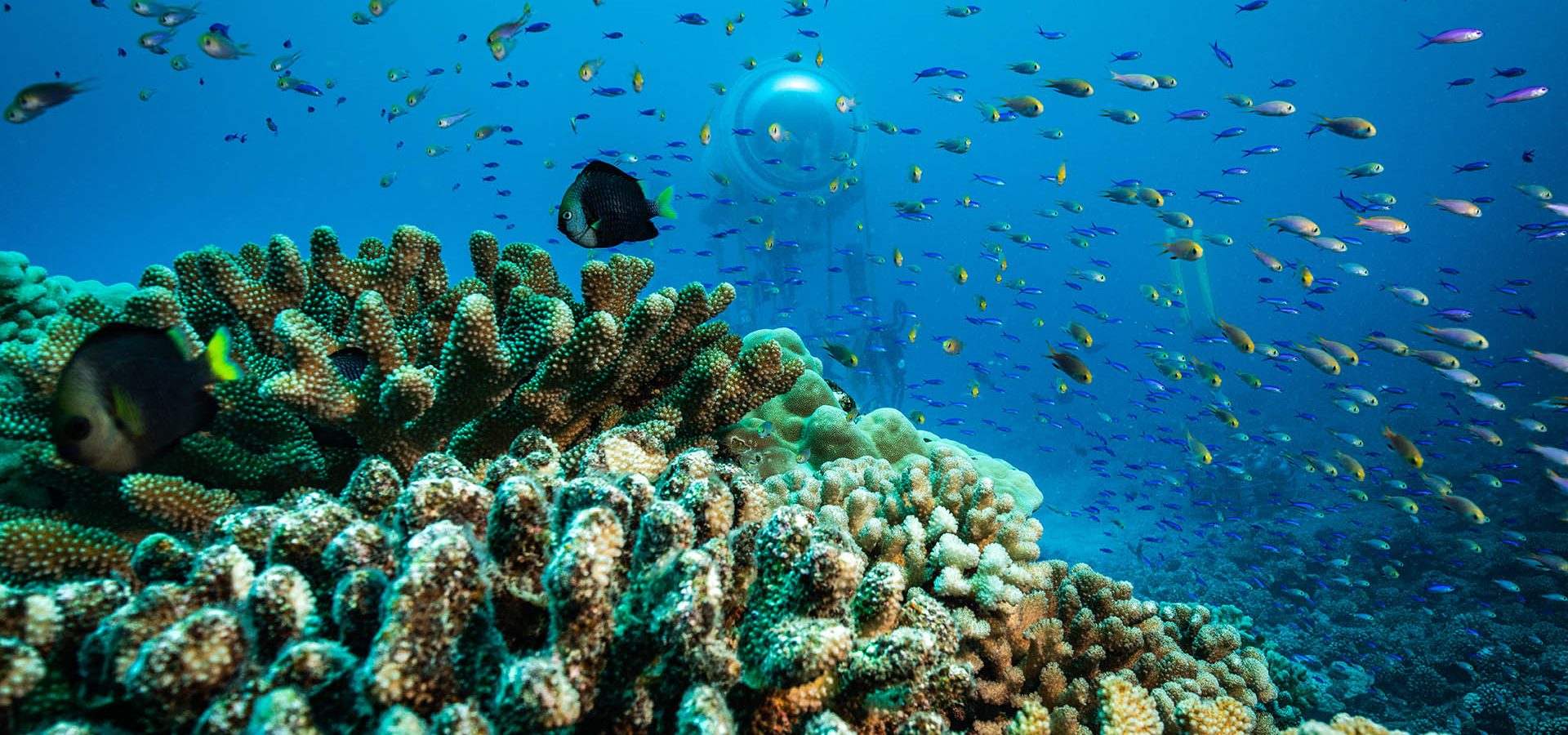
Entering the mesophotic zone requires technical knowledge and experience. Beyond 60 meters in depth, classic diving techniques are no longer sufficient. This difficulty in accessing depths has led to a compartmentalization of knowledge on coastal habitats, with well-known surface ecosystems (0-30m) and unknown mesophotic ecosystems (30-200m).
The diver allows fine observation, precise and fast sampling and incomparable flexibility. The plurality of their senses, the finesse of their movements and their capacity for analysis make humans indispensable as a tool for correctly understanding the underwater ecosystems. But diving in the mesophotic zone requires unique expertise and the very latest technologies. Thus, the collaborative model combining UNDER THE POLE’s diving skill with scientists provides an answer to the need for accurate knowledge of the oceans..
Our two scientific directors are accompanied by a consortium of international researchers and our scientific coordinator.

DEEPLIFE SCIENTIFIC CO-DIRECTOR
CNRS, PSL Research University, EPHE-UPVD-CNRS, USR3278 CRIOBE
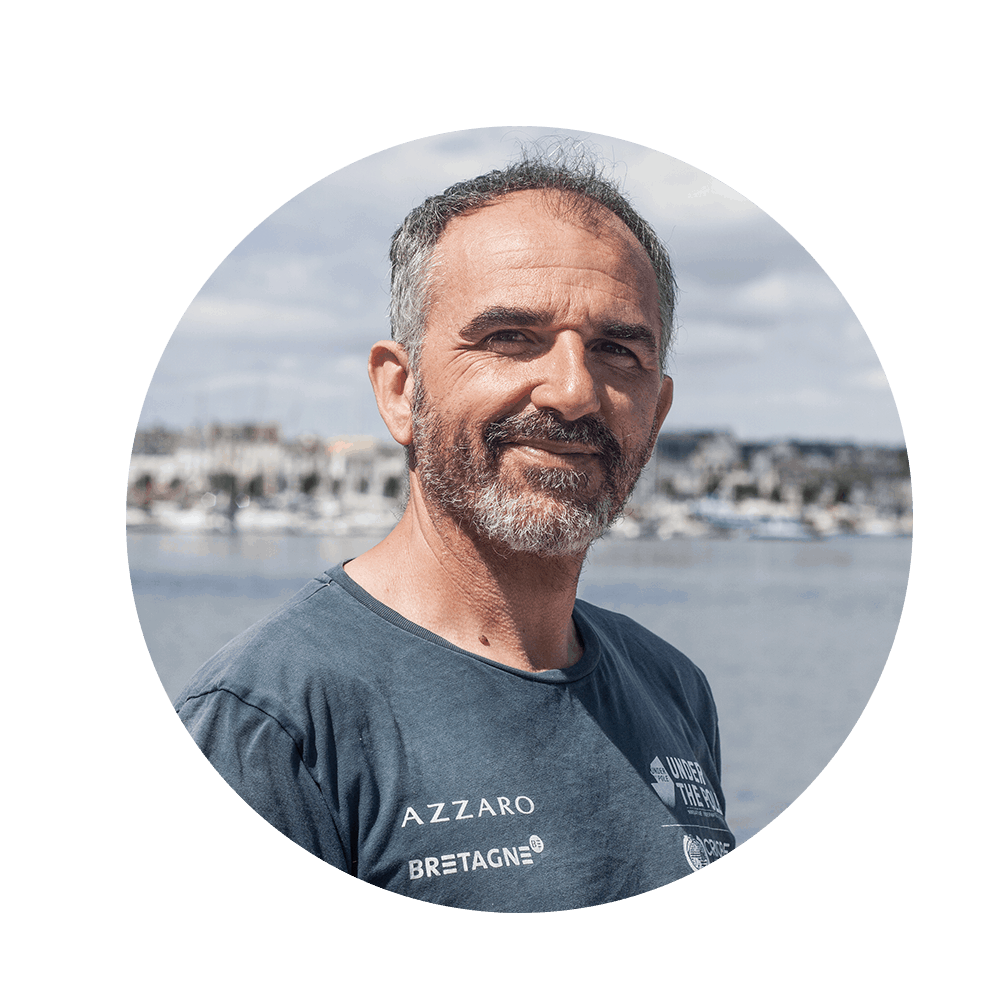
DEEPLIFE SCIENTIFIC CO-DIRECTOR
CNRS, LECOB, UMR 8222

UNDER THE POLE SCIENTIFIC COORDINATOR
Michel ANDRÉ, Laboratory of Applied Bioacoustics, Universitat Politècnica de Catalunya, Spain
Lisandro BENEDETTI CECCHI, University of Pisa, Italy
Hugo BISCHOFF, CRIOBE, CNRS, France
Émilie BOISSIN, CRIOBE, UPVD, France
Pim BONGAERTS, California Academy of Sciences, USA
Isabelle BONNARD, CRIOBE, UPVD, France
Joachim CLAUDET, CRIOBE, CNRS, France
Camille CLERISSI, CRIOBE, EPHE, France
Steeve COMEAU, LOV, CNRS, France
Bruno DANIS, Laboratory of Marine Biology, ULB, Belgium
Vianney DENIS, Institute of Oceanography, National Taiwan University, Taiwan
Lucia DI IORO, CEFREM, UPVD, France
Charlotte DROMARD, BOREA, Université des Antilles, France
Philippe DUBOIS, Laboratory of Marine Biology, ULB, Belgium
Sam DUPONT, Department of Biological and Environmental Sciences, University of Gothenburg, Sweden
Fernando ESPINO RODRIGUEZ, IU ECOAQUA-ULPGC, Spain
Peter FELDENS, Leibniz Institute for Baltic Sea Research Warnemuende, Germany
Karen FILBEE-DEXTER, Norwegian Institute of Marine Research, Norway
Giulia FURFARO, DiSTeBA, University of Salento, Italy
Katell GUIZIEN, LECOB, CNRS, France
Vreni HAÜSSERMANN, Huinay Scientific Field Station, Pontifical Catholic University of Valparaíso, School of Marine Sciences, Faculty of Natural Resources, Chile
Bruno HESSE, OOB, CNRS, France,
Juliette JACQUEMONT, University of Washington, USA
Nadine LE BRIS, LECOB, Sorbonne Université, France
Elisabetta MANEA, National Research Council, Institute of Marine Science, Italy
Giacomo MILISENDRA, Stazione Zoologica Anton Dohrn, Italy
Sandra NAVARRO MAYORAL, IU ECOAQUA-ULPGC, Spain
Francisco OTERO FERRER, IU ECOAQUA-ULPGC, Spain
Éric PARMENTIER , Laboratory of Functional and Evolutionary Morphology, Freshwater and Oceanic Science Unit of Research, University of Liège, Belgium
Valeriano PARRAVICINI, CRIOBE, EPHE, France
Serge PLANES, CRIOBE, CNRS, Polynésie française
Paul RENAUD, Akvaplan-niva,Tromsø, Norway / University Centre in Svalbard, Norway
Luiz ROCHA, California Academy of Sciences, USA
Cristina ROMERA CASTILLO, Instituto de Ciencias del Mar-CSIC, Spain
Sergio ROSSI, DISTEBA, University of Salento, Italy / Labomar, Federal University of Ceará, Bresil
Mischa SCHOENKE, Leibniz Institute for Baltic Sea Research Warnemuende, Germany
Giovanni STRONA, University of Helsinki, Finland
Nathalie TAPISSIER-BONTEMPS, CRIOBE, UPVD, France
Lucas TERRANA, Musée d’Histoire Naturelle & Vivarium de Tournai, Belgium
Fernando TUYA CORTÉS, IU ECOAQUA-ULPGC, Spain
Anton VAN DE PUTTE, University of Liège, Belgium
Mike VAN DER SCHAAR, Laboratory of Applied Bioacoustics, Universitat Politècnica de Catalunya, Spain
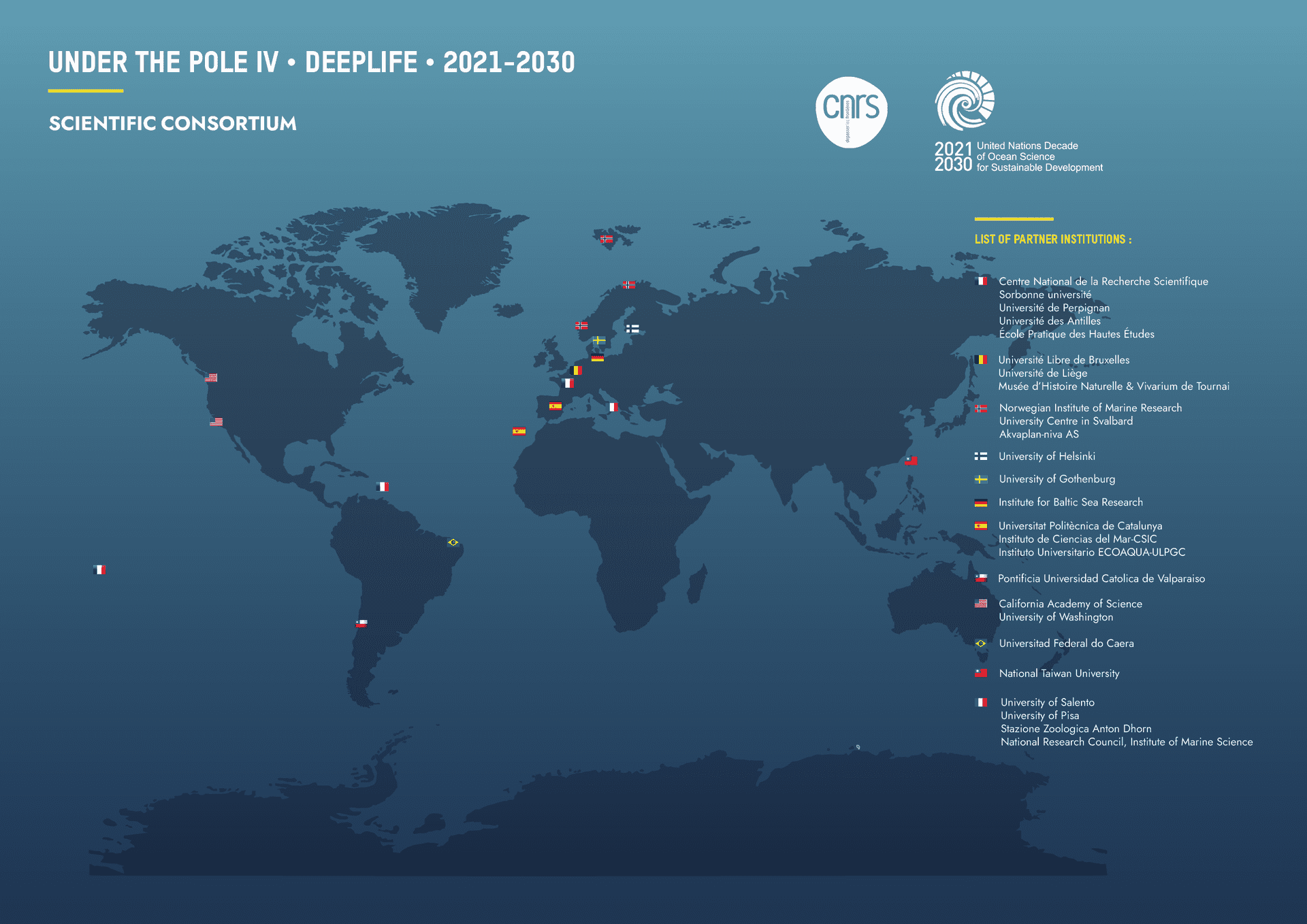
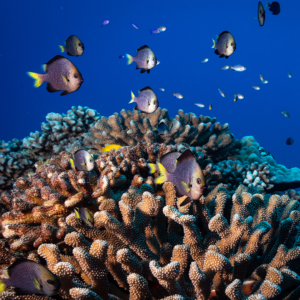 Authors
Authors
Raick X., Di Iorio L., Lecchini D., Gervaise C., Hédouin L., Under The Pole Consortium, Pérez-Rosales G., Rouzé H., Bertucci F., Parmentier E.
Abstract
Contrarily to shallow-water coral reefs, mesophotic coral ecosystems remain largely unknown because they are not easily accessible to humans. Biodiversity associated with corals is therefore also little known, and only sparse information is available on fish communities at these depths.
In order to fill this gap, the present work aimed to characterize the diversity of fish communities in mesophotic coral reefs and determine how this acoustic fish diversity varies depending on the depth and the type of island in six Polynesian islands: three atolls (Rangiroa, Raroia and Tikehau) and three high islands (Bora Bora, Mangareva and Moorea). For this purpose, passive acoustics (study of sounds) was used.
The fieldwork was realized by deep divers from UNDER THE POLE. At each island, three different depths (−20, −60 and −120 m) were sampled simultaneously on the external slope of the reef. At each depth, an underwater long-term acoustic recorder was deployed during 72 h to record fish sounds. In addition, for each island and depth, photo-quadrats (30 quadrats per depth) were realized to characterize the benthic cover (e.g., sand, living scleractinian coral, dead coral, gorgones, black coral, etc.).
Results of the present study show that Polynesian underwater soundscapes are rich, from shallow-water coral reefs to deeper reefs. Fish sounds exhibit a stratification driven by depth, with maximum acoustic diversity at -20 meters. Diversity then decreases down to -60 meters, and is equivalent between -60 and -120 meters. The depth of -60 meters appears to be a transition zone since certain acoustic communities of fish from -20 and -120 meters are found there. This zone is explained by a progressive transition from one assemblage of coral species to another one at this depth. Thus, fish sound diversity reflects indirectly different benthic features. In addition to the differences related to depth and associated benthic cover, part of the acoustic variability is explained by the type of island (high islands or atolls).
In conclusion, acoustic monitoring of fish assemblages reveals subtle differences in benthic cover. The present study opens perspectives in the monitoring of mesophotic coral ecosystems using passive acoustics, which is a promising tool to follow temporal changes in the depths.
Authors
Godefroid M., Dubois P., Under The Pole Consortium, Hédouin L.
Abstract
Les écosystèmes coralliens mésophotiques (30-150m de profondeur) sont des oasis de biodiversité. Les travaux antérieurs du programme DEEPHOPE ont révélé que la diversité des coraux constructeurs de récifs (c’est-à-dire les coraux scléractiniaires) est étonnamment plus élevée dans la zone mésophotique (40-60m) que dans les récifs de surface, et que ces coraux mésophotiques échappent au blanchiment corallien (voir nos publications par Pérez-Rosales, 2021 & 2022).
Reef-building corals co-exist with antipatharians, commonly known as black corals. Antipatharians are particularly abundant at mesophotic depths, where they can form dense aggregations called Marine Animal Forests. These habitats act as spawning, nursery and feeding areas that support diverse animal communities, and create biodiversity hotspots.
Understanding the capacity of mesophotic corals to cope with heat stress is important to predict how climate change will shape the future of the reefs, from shallow to mesophotic areas.
The collaboration between UNDER THE POLE, the Université Libre de Bruxelles, and the French National Centre for Scientific Research (CNRS) allowed to assess for the first time the thermal sensitivity of corals from lower mesophotic zone at 85 m depth (45m at the deepest in previous studies). Coral sensitivity to global warming was compared to the ones of shallower corals at 25m depth.
Sampling of corals (Reef-building corals: Pachyseris speciosa, black corals: Stichopathes sp.) was carried out in Mo’orea (French Polynesia) at 25m and 85 m depth by technical divers from UNDER THE POLE. Corals were installed in 200 L-aquaria to be exposed to different temperature treatments (23°C to 32°C) for 10 days. Thermal performances and metabolic responses of corals were determined to assess their capacity to cope with heat stress.
We revealed that mesophotic reef-building corals have a higher capacity to encompass large range of temperatures compared to their congeners at 25 m depth. It is likely because mesophotic colonies are exposed to more variable seawater temperatures created by the rise of deep cold and nutrientrich waters being uplifted up the reef slope (called internal waves). In Mo’orea, temperature variability increases with depth, with a temperature range of 4.6 °C at 90 m vs 2.9 °C at 20 m.
The present study also shows that black corals have lower thermal window of performance compared to reef-building corals in response to heat stress. It confirms our previous results revealing that black corals have poor thermal acclimatization capacity. Global warming could have significant consequences for this ecosystem-engineer species (see our publication by Godefroid et al., 2022).
En conclusion, la plus grande performance thermique des coraux mésophotiques met en évidence le rôle de la zone mésophotique en tant qu’oasis de biodiversité, résistante à un stress thermique. Les écosystèmes mésophotiques sont probablement plus tolérants au réchauffement climatique que leurs homologues moins profonds et leur prise en considération sera un atout important à l’avenir pour la gestion et la conservation de la biodiversité.
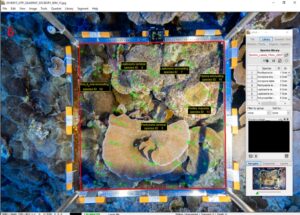
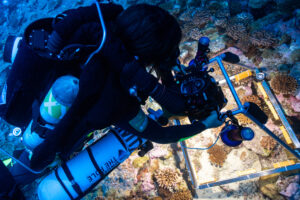
Authors
Pérez-Rosales G., Hernandez-Agreda A., Bongaerts P., Rouzé H., Pichon M., Carlot J., Torda G., Under The Pole Consortium, Parravicini V, Hédouin L.
Abstract
While mesophotic coral ecosystems have been suggested as biodiversity hotspots, potential short-term thermal refuges and larval sources for damaged shallow reef areas, they have been overlooked in conservation efforts because they are still largely understudied due to logistical and cost challenges. To advance coral reefs’ conservation strategies, it is crucial to identify mesophotic coral reefs showing high coral cover and the environmental factors that influence such coral ‘hotspots’.
For this purpose, UNDER THE POLE and scientists from the DEEPHOPE expedition explored eight islands across French Polynesia over a wide depth range (6 to 120 m). The evaluation of the 2880 photoquadrats revealed that 30% of mesophotic studied sites (20 out of 64 sites) exhibited higher coral cover than predicted (Bayesian models). The highest coral cover at the mesophotic depths was observed in Gambier islands, with > 40% coral cover at 90 m and 120 m versus the average expected values based on the model of less than 15% at 90 m and 10% at 120 m. The most influencing factors for the likelihood of high coral coverage are the light, the type of substrate (hard substrates) and the reef slope (moderate to steep slopes of 30 to 70°).
The present work unveils the presence of unexpectedly and unique high coral cover communities at mesophotic depths, highlighting the importance of expanding the research on mesophotic depths for coral reef conservation.
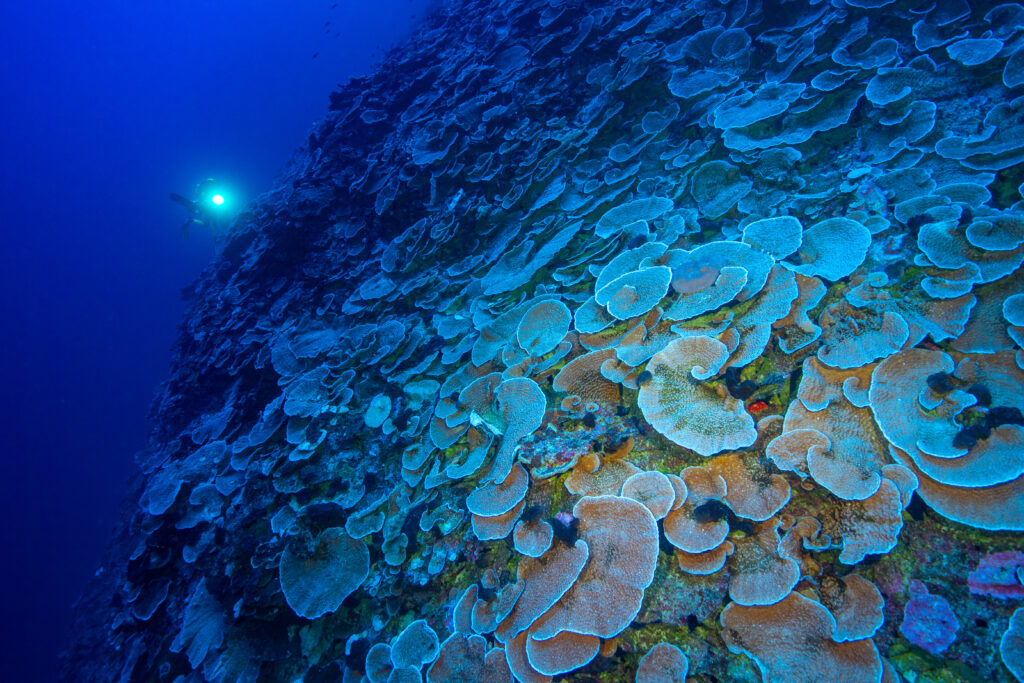
Authors
Pérez-Rosales G., Pichon M., Rouzé H., Villeger S., Torda G., Bongaerts P., Carlot J., Under The Pole Consortium, Parravicini V, Hédouin L.
Abstract
Mesophotic coral ecosystems might be crucial for the conservation of coral reefs.
This new article reveals that coral diversity is unexpectedly higher in the mesophotic range (40-60m) than in shallow reefs. Indeed, this mid-zone hosts coral assemblages typical of both ranges, the shallow and deep reefs; thus, it could act as a safeguard of biodiversity.
At the same time, while the diversity of shallow reefs is similar among islands, the diversity of mesophotic reefs differs from site to site. These pioneering findings challenge our perception of conservation needs.
We provide new perspectives that if we seek to preserve the coral biodiversity, efficient conservation of coral reefs requires considering mesophotic depths and site-specific measures. This is particularly relevant in the light of ever-increasing human pressures and climate change effects, which seem to be less severe with increasing depth.
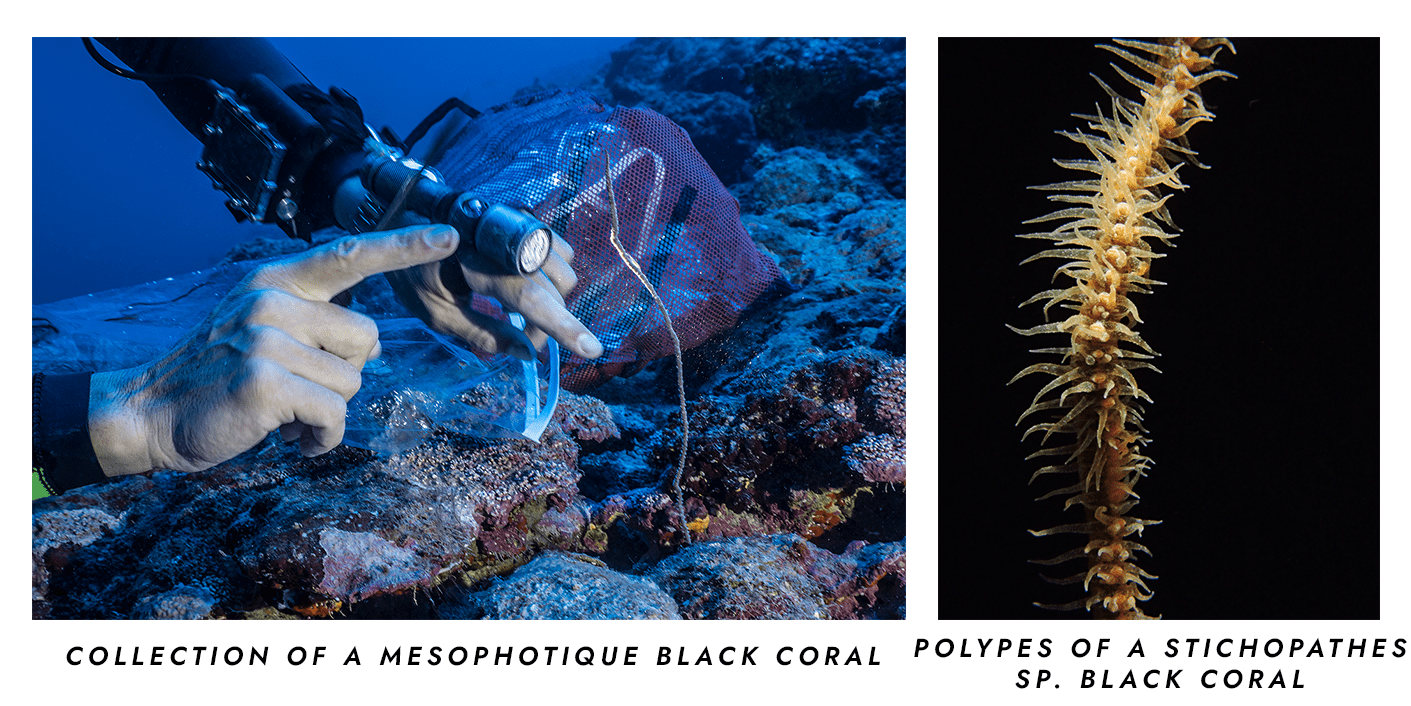
Authors
Godefroid M., Hédouin L., Mercière A., Under The Pole Consortium, Dubois P.
Abstract
An understanding of all components of coral ecosystems is essential to predict effects of global warming. Antipatharians, also called black corals, are components of mesophotic coral ecosystems (MCE). Antipatharians are present in almost all oceans of the world and their abundance reach a peak at mesophotic depths. Antipatharians can play a key role in MCE by forming black coral forests, which act as spawning, nursery and feeding areas that support diverse animal communities, and create biodiversity hotspots.
The collaboration between UNDER THE POLE, the Université Libre de Bruxelles, and the French National Centre for Scientific Research (CNRS) allowed to fill the gap of knowledge on black coral sensibility to global warming. We provided the first assessment on the susceptibility of black coral to thermal stress, by working on the mesophotic antipatharian Stichopathes sp. from Mo’orea (French Polynesia).
Sampling was carried out between 70 and 90 m depth by technical divers from UNDER THE POLE. Corals were installed in 200 L-aquaria to be exposed to four temperature treatments (26°C control temperature, 27.5°C, 29°C and 30.5°C) through a 16-d laboratory exposure. To assess their physiological capability to cope with heat stress, metabolic, biochemical, and cellular responses of corals were determined.
The optimal temperature, i.e. allowing the black coral Stichopathes sp. to efficiently perform its biological functions, was determined around 28.3 °C. The first signs of stress were observed around 29°C, revealing a narrow thermal window of performance for this coral.
These results suggest that black corals have poor thermal acclimatization capacity. A 1°C increase could have significant consequences for this foundation species.
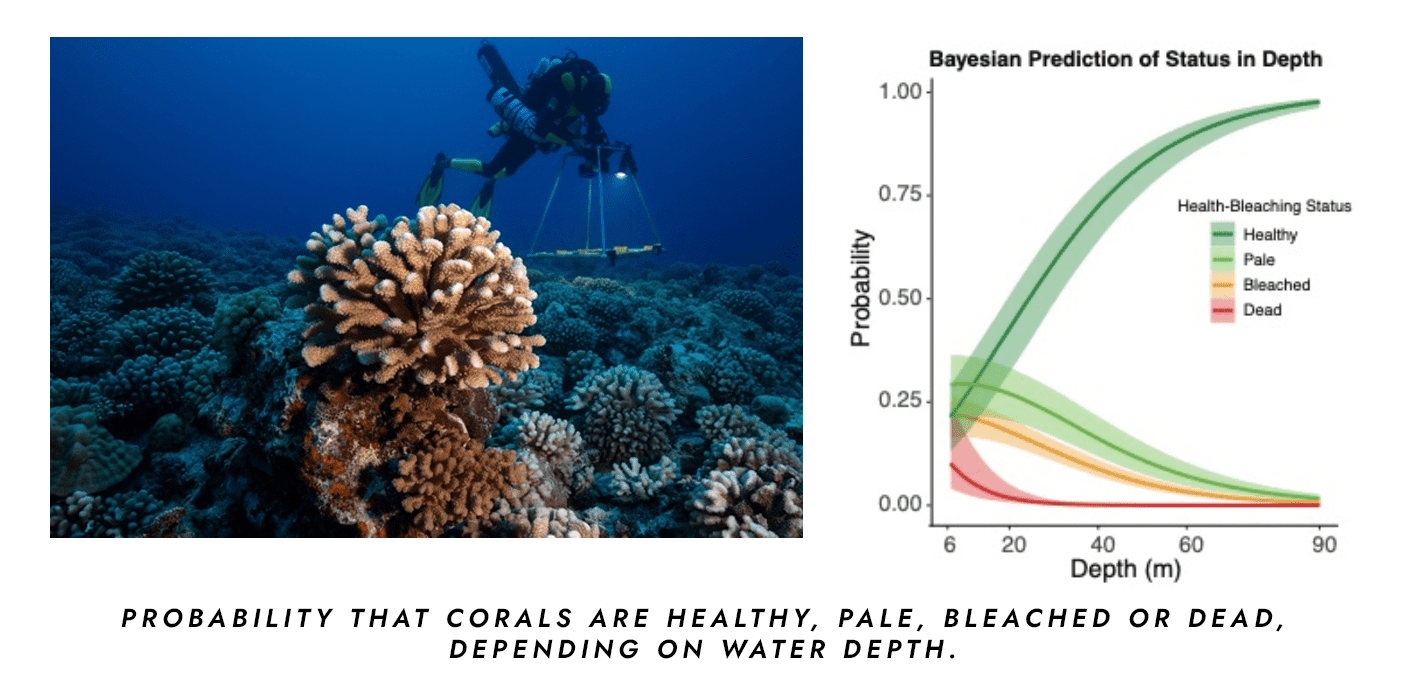 Authors
Authors
Pérez-Rosales G., Rouzé H., Torda G., Bongaerts P., Pichon M., Under The Pole Consortium, Parravicini V., Hédouin L.
Abstract
The mesophotic zone rises as a refuge for corals from accelerating global warming.
Climate change and consequent global warming are causing the disappearance of reefbuilding corals worldwide because of coral bleaching. While bleaching episodes significantly impact shallow waters, little is known about their impact on mesophotic coral communities.
During the heatwave that affected Polynesian reefs in 2019, scientists from the “DEEPHOPE” expedition monitored with UNDER THE POLE the bleaching effects along an extreme depth range (6 to 90 m), a worldwide premiere. This pioneering survey reveals that the incidence of coral bleaching decreases with depth, with no bleaching observed at lower mesophotic depths (>= 60m).
The mesophotic zone (between 30 – 150 m) rises as a potential refuge and may play a role in providing extra time for corals from escalating global warming compared to the surface.
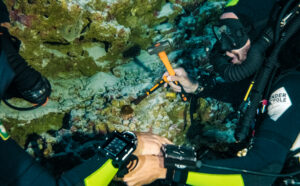 Authors
Authors
Rouzé H., Galand P.E., Medina M., Bongaerts P., Pichon M., Pérez-Rosales G., Torda G., Moya A., Under The Pole Consortium, Raina J.B., Hédouin L.
Abstract
A new vision of coral reefs
Coral reefs are one of the most productive and diverse ecosystems on Earth. Hard coral, which builds reefs, relies mainly on a symbiotic relationship with microalgae (zooxanthellae) to power, among other things, the energetic needs of calcification. During the symbiosis, the coral provides limited inorganic nutrients, while algae share essential organic compounds (e.g., sugars) derived from their photosynthetic activity. Thus, the symbiosis between reefbuilding corals (photosynthetic scleractinian corals) and microalgae underpins the health and productivity of tropical coral reef ecosystems.
Although coral ecosystems extend into the depths, this symbiotic relationship has mainly been studied in shallow waters (<30 m) because of technical limitations imposed by traditional scientific scuba diving. We do not know how deeper corals, inhabiting large and vastly underexplored mesophotic coral ecosystems, modulate their symbiotic associations to grow in environments that receive less than 1% of surface light.
To better understand how reef-building corals can survive so far away from their presumed light optimum, the DEEPHOPE program brough together the scientific expertise of an international consortium and the diving exploration expertise of UNDER THE POLE. This program made it possible, for the first time, to study of scleractinian corals on a wide depth gradient (6 to 172 m) and geographic scale (5 archipelagos of French Polynesia) in order to push the limits of our knowledge of corals.
This study allowed the discovery of the deepest photosynthetic hard coral at 172 m depth. The analyzes of symbiotic communities show that the coral, identified as Leptoseris hawaiiensis, survives at such depth by hosting Symbiodiniaceae, predominantly of the genus Cladocopium, but also a single species of endolithic algae from the genus Ostreobium. These algae in the coral skeleton are adapted to photosynthesize in near-darkness using shorter wavelengths compared to other zooxanthellae and optimize light capture. Morphologically, L. hawaiiensis is characterized by a thin flat skeleton, which is optimal for light harvesting and reducing skeletal carbonate deposition. Thus, this coral species uses different strategies to acclimate and survive in extreme low light conditions.
The present results report a new depth record for photosynthetic scleractinian corals at 172 m and provide a new vision of coral reefs. These ecosystems have been extensively studied in shallow waters, which represents less than one-fifth of the total depth range of the tropical coral reefs. Depth is a dimension that can no longer be ignored in future studies to understand coral ecosystems. A better knowledge of coral ecosystem functioning is necessary for the implementation of effective management and preservation measures of these threatened ecosystems.
“Ecology of coral reef fish Part A: Bio- and Ecoacoustics”. Présentation orale, Current issues in oceanography, Belgique, octobre 2022
“Diversity of mesophotic coral reefs fish fauna through passive acoustics”. Présentation orale, ZOOLOGY 2022 Benelux Congress of Zoology, Belgique, septembre 2022
“Diving deep in French Polynesia reveals new insights into the ecological importance of mesophotic coral ecosystems”. Présentation orale, 15th International CoralReef Symposium (ICRS), Allemagne, juillet 2022
“Tropical black corals have higher thermal sensitivity than temperate ones”. Présentation orale, 15th International CoralReef Symposium (ICRS), Allemagne, juillet 2022
“High susceptibility of tropical black corals in comparison with temperate and subtropical ones”. Présentation orale, Gordon Research Seminar & Poster presentation, Gordon Research Congress, juillet 2022
“Passive acoustic monitoring of fish diversity in mesophotic coral ecosystems, potential global-change refuges“. Oral presentation, BIODIVERSITY 2022 « Biodiversity in a rapidly changing world », Belgium, April 2021
“Under The Pole Scientific Mission to explore Polynesian reefs: differences between photic and mesophotic fish biophonies“. Oral presentation, Scientific Missions and their Advancement for Overseas Sciences: Past, Present and Future, Belgium, December 2021
“Les coraux mésophotiques: présentation du projet DEEPHOPE“. Oral presentation to la direction des Ressources Marines, French Polynesia, November 2021
“Does high-frequency temperature fluctuations at depth increase the thermal resilience of local populations? Comparison between antipatharians and scleractinians from Mo’orea, French Polynesia“. Présentation orale, conférence PhysioMar, Nouvelle-Zélande, Septembre 2021
“Les enjeux de l’exploration scientifique de la zone mésophotique: des coraux aux forêts animales marines“. Présentation orale, Congrès mondial de la nature de l’UICN, France, septembre 2021
“Deep diving in paradise shines new light on the twilight zone: preliminary results of the DEEPHOPE mesophotic programme in French Polynesia”. Présentation orale, 14th International Coral Reef Symposium (ICRS), Allemagne, juillet 2021
“Do we really know the scleractinian coral’s microbiome in the twilight zone?”. Présentation orale, 14th International Coral Reef Symposium (ICRS), Allemagne, juillet 2021
“Is local adaptation driving thermal tolerance at mesophotic depths? Insights from Stichopathes sp. subjected to internal waves in Mo’orea”. Présentation orale, Society for Experimental Biology, virtual conference, juillet 2021
“Ocean warming effects on a mesophotic antipatharian species from French Polynesia”. Présentation d’un poster, Young Researchers’ Overseas Days 2020, Académie Royale des Sciences d’Outre-mer, Belgique, décembre 2020
“Responses of antipatharians to heat stress: an eco-physiological study of a mesophotic species from French Polynesia”. Présentation orale, YOUMARES 11 Conference, Allemagne, octobre 2020
“En quête du corail noir de Polynésie française”. Présentation orale, Prix Europcar 2019 pour la recherche, Polynésie française, décembre 2019
Don't miss the latest news and previews!
Data Protection Act of 6 January 1978 : the undersigned is informed that his personal data will be collected and processed electronically by the Club. This data will be stored by the UNDER THE POLE for administrative purposes for a period of 3 years. The undersigned is informed of his right of access, communication and rectification, in case of data proven inaccuracy as well as his right to oppose the processing and / or publication of his data for legitimate reasons. To do so, simply send an email to the following address: contact@underthepole.com
At your service
Data Protection Act of 6 January 1978 : the undersigned is informed that his personal data will be collected and processed electronically by the Club. This data will be stored by the UNDER THE POLE for administrative purposes for a period of 3 years. The undersigned is informed of his right of access, communication and rectification, in case of data proven inaccuracy as well as his right to oppose the processing and / or publication of his data for legitimate reasons. To do so, simply send an email to the following address: contact@underthepole.com
Partnership
Get a file
Data Protection Act of 6 January 1978 : the undersigned is informed that his personal data will be collected and processed electronically by the Club. This data will be stored by the UNDER THE POLE for administrative purposes for a period of 3 years. The undersigned is informed of his right of access, communication and rectification, in case of data proven inaccuracy as well as his right to oppose the processing and / or publication of his data for legitimate reasons. To do so, simply send an email to the following address: contact@underthepole.com
Data Protection Act of 6 January 1978 : the undersigned is informed that his personal data will be collected and processed electronically by the Club. This data will be stored by the UNDER THE POLE for administrative purposes for a period of 3 years. The undersigned is informed of his right of access, communication and rectification, in case of data proven inaccuracy as well as his right to oppose the processing and / or publication of his data for legitimate reasons. To do so, simply send an email to the following address: contact@underthepole.com